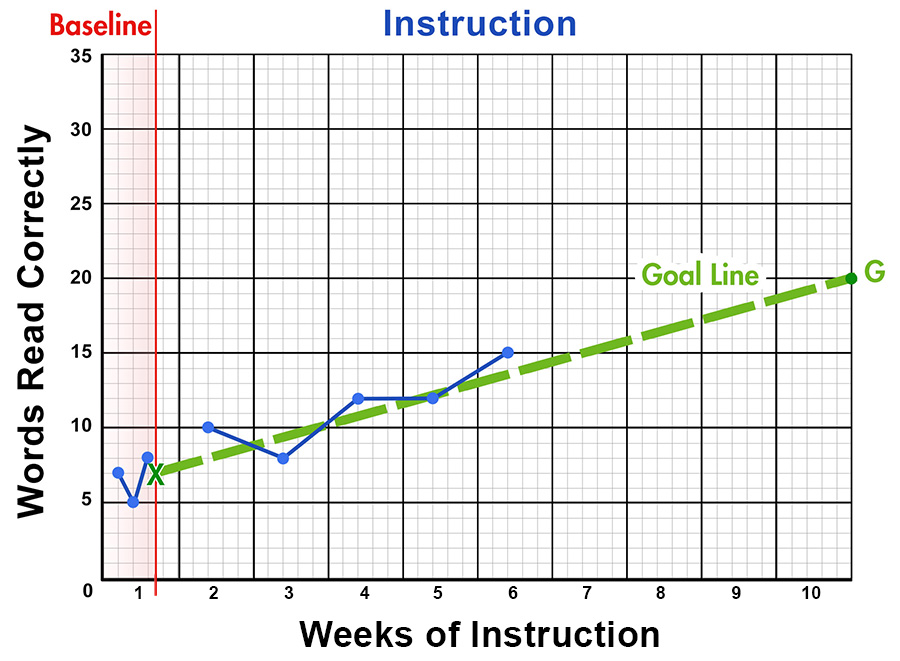How can teachers determine whether students are making appropriate progress?
Page 6: Administer, Score, and Graph
 After preparing a graph for each student, now the educator is ready to administer and score GOM reading measures. The educator should take care to ensure fidelity of implementation by following any accompanying guidelines for the measure. After administering and scoring each probe, the educator should graph each student’s scores to create a visual representation of his performance over time. Read on to learn more about this process.
After preparing a graph for each student, now the educator is ready to administer and score GOM reading measures. The educator should take care to ensure fidelity of implementation by following any accompanying guidelines for the measure. After administering and scoring each probe, the educator should graph each student’s scores to create a visual representation of his performance over time. Read on to learn more about this process.
implementation fidelity
glossary
Administer Measures
For Your Information
To monitor the progress of struggling students, educators should administer measures weekly or twice weekly. More frequent monitoring enables educators to make decisions and adjust instruction, if needed, more quickly.
The educator should administer the selected progress monitoring measure frequently and at regular intervals. Although some measures are designed to be used once or twice per week, others are designed to be used once or twice per month. (Some commercially available measures indicate how frequently the measure should be administered.) At a minimum, though, progress monitoring measures should be administered once per month. Reading measures can be administered in a variety of ways. These include:
- Individually — Educators administer measures (e.g., letter sound fluency, word identification fluency, passage reading fluency) to individual students.
- In groups — Educators administer measures (e.g., maze) to the entire class at the same time.
- Using a computer — Students individually complete the measures on a computer.
Regardless of how they are administered, probes have a specified time limit. Although some require more time, many measures take only one to eight minutes to administer, depending on the grade level and the type of measure.
Tips for Administering Probes
- Explain to students that although they may have low scores at first, as the year progresses and they learn new skills, their scores will increase.
- Establish consistent administration procedures. Doing so facilitates the comparison of student performance over time and helps confirm that their scores are accurate reflections of their ability and not the result of inconsistent administration.
- Administer probes back-to-back at the same time of day and in the same order.
- Have two copies of the reading probe available—one for the student to read and one for the educator to mark errors.
- If possible, avoid increasing the allotted probe completion time for students with testing accommodations because this prevents the comparison of student scores to national norms. When time increases are necessary, provide the same duration each time a probe is administered.
Score Measures
Commercially available probes include detailed scoring procedures that are standardized to produce reliable and valid scores. Failing to follow the scoring procedures can lead to inaccurate and misleading conclusions. In general, scoring a reading probe is a matter of determining how many words the student read or identified correctly. However, these scoring criteria may vary across different commercially available products. For instance, for reading fluency, one may count the mispronunciation of a proper noun only once while others may penalize the student for each mispronunciation of the same proper noun.
Tip
When administering a probe for English learners, be sure to consider their accent and dialect before marking a response as incorrect.
Demonstration of Administering and Scoring CBM Probes
The three students below are in Ms. Chee’s fourth-grade classroom. Ms. Chee administers a word identification probe to José because he is currently reading at a first-grade level. Typically, Ms. Chee uses maze measures with the students in her class, but for the sake of this illustration, let’s say she is administering a passage reading fluency measure to Sidney. Click on each student’s picture below to view demonstrations of Ms. Chee administering and scoring each of these measures.
José (time: 2:57)
Word Identification Fluency
Narrator: Word identification fluency measures are designed to be used with first-grade students or those reading below grade level and not able to read passages. This type of measure must be administered to each student individually. Students are presented with a list of 50 words and asked to read as many of them as possible in one minute. Words are randomly selected from a list of the 500 most frequent sight words.
Narrator: The teacher also has a copy of the word list, marking a “1” if the student reads the word correctly and a “0” if he does not. For English learners, the teacher should consider the student’s accent and dialect before marking a response incorrect. To determine the score, the teacher counts the number of correct responses.
Narrator: Watch as Ms. Chee administers a word identification fluency measure to an individual student, José.
Ms. Chee: Hi, José. When I say “go,” I want you to read these words as quickly and correctly as you can. Start here and go down the page. If you don’t know a word, skip it and try the next word. Keep reading until I say “stop.” Do you have any questions?”
José: No.
Ms. Chee: Go.
José: [Reads the word list in the movie.]
Ms. Chee: Stop.
Narrator: When the one-minute time limit is up, Ms. Chee circles the last word read by José. To score this test, Ms. Chee counts the number of words read correctly in one minute and writes the score at the bottom of the scoring form.
Narrator: José read 27 words correctly in one minute. Therefore, José’s score is 27.
Word identification fluency measure is courtesy of Lynn and Doug Fuchs, adapted by the IRIS Center.
Sidney (time: 3:25)
Oral Reading Fluency or Passage Reading Fluency
Narrator: Oral reading fluency or passage reading fluency
Oral reading fluency, sometimes referred to as passage reading fluency (PRF), is used with students from mid-first to sixth grades. A passage reading fluency measure is administered to each student individually. For the first administration, the teacher provides the full set of instructions but offers abbreviated instructions for subsequent administrations. Students are given one minute to read the passage.
Words read correctly are scored as correct.
If the student self-corrects within three seconds, the word is counted as correct.
Words that are mispronounced, omitted, substituted, or reversed are counted as errors.
If the student hesitates for more than three seconds, the word is provided by the teacher and counted as an error.
Repetitions and insertions are ignored.
Watch as Ms. Chee administers a passage reading fluency measure to Sidney.
Ms. Chee: Sidney, I want you to read this story to me. You’ll have one minute to read. When I say “begin,” start reading aloud at the top of the page. Do your best reading. If you have trouble with a word, I’ll tell it to you. Do you have any questions?
Begin.
Sidney: Mom was going to have a bay, bay, babe. [pause] Another one! That is all we need though, thug, taught [pause] Samantha who was ten years old. Samantha had two little brothers.
They was, were brats. Now Mom was going to have another one. Samantha wanted to cry.
“I need you help,” said Mom. “I hope you, I hope you will keep an eye on the boys when I am…”
Ms. Chee: Stop.
Narrator: To score this passage, Ms. Chee counts the number of words Sidney read in one minute. She uses the numbers at the end of each line in the passage to help. Sidney finished with the word “am.” Ms. Chee looks at the line before the last word. There are 56 words. She then counts the number of words in the next line: 57, 58, 59, 60, 61. So Sidney read a total of 61 words.
Sidney made a total of five errors. There were two hesitations, two mispronunciations, and one omission. Sidney also repeated one phrase, but according to the scoring rules for passage reading fluency, this is ignored. Sidney also replaced the word “were” with “was” but changed it back within three seconds, so it was counted as correct.
Sidney’s five errors are subtracted from the total number of words read (61). So her score is 56 correct words read in one minute.
Oral reading fluency measure is courtesy of Lynn and Doug Fuchs.
Madison (time: 2:30)
Maze Fluency
Narrator: Maze fluency measures are designed to be used with students in fourth through sixth grade. They can be administered either to a group of students or to an individual student. For the initial administration, the teacher provides the full set of instructions but offers abbreviated instructions for subsequent administrations. Students are given two and a half minutes to read a passage to themselves and asked to circle a word to correctly fill each blank they encounter. The teacher monitors the students during the test and scores each test later.
Watch as Ms. Chee administers a maze fluency measure to an individual student, Madison.
Ms. Chee: Hi, Madison. Look at this story. It has some places where you need to choose the correct word. Whenever you come to three underlined words in parentheses, choose the word that belongs in the story. Listen. The story begins, “Mrs. Jones said that Cindy’s class was going on a field trip. The [stare/class/green] of third-graders had never been on a field trip before.” Which one of these three underlined words [stare/class/green] belongs in the sentence?
Madison: Class.
Ms. Chee: That’s right. The word that belongs in the sentence is “class,” so you circle the word “class.”
Now you are going to do the same thing by yourself. Whenever you come to three underlined words in parentheses, circle the word that belongs in the sentence. Choose a word even if you’re not sure of the answer.
When I tell you to start, pick up your pencil, turn your test over, and begin working. At the end of two and a half minutes, I’ll tell you to stop working. Remember, do your best. Any questions?
Start.
Stop.
Narrator: Once Madison completes the test, Ms. Chee is ready to score it. The score is the number of correct words the student has circled. If the student makes three consecutive errors, scoring is discontinued—that is, no subsequent correct answer is counted. Skipped blanks, those where no word is circled, are counted as errors.
Note that Madison circled 16 correct answers in two and a half minutes. However, she made three consecutive mistakes, and two of her correct answers came after those errors. Therefore, Madison‘s score for this maze fluency test is 14.
Maze fluency measure is courtesy of Lynn and Doug Fuchs, adapted by the IRIS Center.
Activity
It’s your turn! Practice administering and scoring the different reading CBM probes by clicking on each student’s picture below. Try all three and compare the differences in administration and scoring.
Fluency measures are courtesy of Lynn and Doug Fuchs.
Graph Scores
After administering and scoring each probe, the educator should graph the scores to create a visual representation of each student’s performance over time. Most companies that provide progress monitoring measures include a tool that graphs students’ test scores (i.e., data). Alternatively, the educator or the student can graph the scores on paper or by using a graphing program or application. Regardless, by examining the data on the GOM graph, the educator can determine whether a student is making adequate progress.



